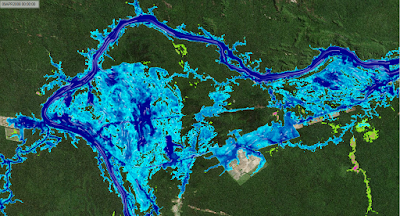2D flood model preferences
As a result, there were many discussions about "which one is the best 2D flood model?".
Personally, I consider that all models that satisfy some benchmarking tests (to verify their accuracy by comparing with some known cases) are good and will provide good results when properly used (adequate selection of cell size, coefficients, boundary conditions). I consider that the main differences between different 2D models are:
Personally, I consider that all models that satisfy some benchmarking tests (to verify their accuracy by comparing with some known cases) are good and will provide good results when properly used (adequate selection of cell size, coefficients, boundary conditions). I consider that the main differences between different 2D models are:
- Computing cost. Some models demand more computing time and use bigger files.
- Graphical user interface. This is the main difference in any computer program. Software developed by different developers have different GUI. Some are more friendly and some not.
- User experience. Maybe this one is the most important one. When a user begins to use one model, he becomes familiarized with its interface and its performance. Thus, the users develops an intuitive knowledge about this model and becomes faster at using it.
Poll
This post is a poll about the preferences when selecting a 2D flood model. 10 of the most popular 2D flood models are presented for you to selecte the model that you prefer. The models considered in this survey were selected considering:
- Their performance was verified considering at least 7 benchmarking tests of the UK Joint Defra Environment Agency (Reference 1, Reference 2).
- ANUGA: An Open Source Hydrodynamic / Hydraulic Modelling. Most of its components are written in the object-oriented programming language Python. Thus, it is possible to use it via Python scripts.
- Delft3D: Developed and maintained by Deltares. Although the full potential of this model is for simulating 3D flows, it is also possible to perform 2D simulations by considering one vertical depth averaged layer.
- Flo-2D: Developed and maintained by Flo-2D software. This model is based on finite elements.
- Flood modeller pro: One of the most popular models in UK, and during the last years it got a fast growing number of users thanks to the release of a free version. It is the latest update of ISIS.
- HEC-RAS: Developed and maintained by the USACE. This is one of the most popular hydraulic models. For many years it was limited to 1D flows. However, the HEC-RAS version 5 released in 2015 also includes 2D capabilities.
- InfoWorks ICM: A very popular model from UK. This model does not only solves the 1D-2D overland flow, but it provides a complete catchment modelling including hydrology and underground drainage sewer systems .
- ISIS2D: A very popular model in the UK. However, in was replaced by Flood Modeller Pro, which is the latest update of ISIS, and integrates bith the 1D and the 2D.
- LISFLOOD: Developed and maintained by the University of Bristol. Unlike the other models, this model does not solve hydrodynamic differential equations, but it is based on cellular automata. Thus, it does not require much computing power and the computations are very fast.
- MIKE21 - MIKE Flood: Developed and maintained by DHI. This is one of the 2D flood models with more cases studies in the world.
- Sobek 1D2D: Developed and maintained by Deltares. This model was designed specifically for rivers. It was one of the first models to include the hybrid 1D2D capabilities; the main channel simulated as 1D, while the floodplains are simulated as 2D.
- TELEMAC: Developed and maintained by the TELEMAC-MASCARET consortium. This finite element based model was initially developed by SOGREAH, but in 2010 it was released as a free model by the mentioned consortium
- TUFLOW: Developed and maintained by BMT WBM. I think that this was the first model that included the nested grid capabilities.
- XP solutions: It provides a set of models for water resources, drainage and flood hazard. It includes broader scope of tools for including the effects of civil infrastructure.
You can view the current results (percentage of preference) in the following link. Although I have my preference, I will not participate in this poll, as I do not considered it to be fair (I organize the poll). If there is another model that you would like to include in the poll, please let me know (the model needs to verify the benchmarking tests).















4 comments
How many did actually participate in this interesting pole?
Thanks for the question. It began monday. Last time I checked there 120 votes. I will add the possibility to view all the votes
The votes can be viewed in this link. I also included the summary view after submit the form and the link in the form
https://docs.google.com/spreadsheets/d/1tW-pakPPPciUEngEJCs1TbsTPptG_HhAKnvfkPd_cPQ/edit#gid=2004667282
Great idea for the survey. I’ve noticed it looks like there are repetitive votes seconds apart for the same 2D model. I’ve just done a test and you can repeatedly vote from the same device!!! So sadly, I suspect this survey may now be a bit of a joke? :(
Post a Comment